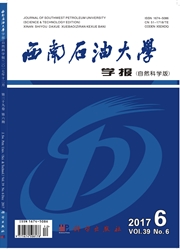

 中文摘要:
中文摘要:
黄龙场构造位于川东大巴山褶皱带与川东弧形褶皱带交汇处,构造及其演化特征复杂,地震剖面上发育深、浅两套断层褶皱构造体系。通过地震剖面和水平切片反射特征分析,厘清了断裂类型与分布特征,建立了对应的构造样式,并对其进行了地震正演数值模拟以确定构造样式的合理性。在此基础上,开展了构造及其演化特征分析,指出了黄龙场构造发育时期和构造演化特征。中生代以来,黄龙场地区先后经历了印支早期低幅度隆起发育期、印支晚期大幅度冲断褶皱发育期、燕山期小规模挤压调整发育期和喜马拉雅期继承性隆升发育期4个构造发育阶段.
 英文摘要:
英文摘要:
Huanglongchang structure is located at the cross point of in Dabashan fold belt and east arc fold belt of the Sichuan Basin, which is complex in the structure and the tectonic movement. There are two types of fold belt systems in the deep and shallow underground. Through the analysis of seismic slice and horizontal slice, the type of the fracture and its distribution feature were recognized, and the corresponding texture style was estblished. Some forward modeling on these structures have been done to verify the rationality of them. Based on the study, we analyse the tectonic movement and its characteristics, and determined the time of the tectonic development and structure evolution feature of Huanglongchang. the development of structures in Huanglongchang is classified four stages : Early Indosinian low uplift period, the late Indosinian great thrust fold development period, Yanshan epoch small extrusion fracture development period, and the Himalayan inherited uplift period.
 同期刊论文项目
同期刊论文项目
 同项目期刊论文
同项目期刊论文
 The seismogenic structure of the 2010 Suining Ms 5.0 Earthquake and Its geometry, kinematics and dyn
The seismogenic structure of the 2010 Suining Ms 5.0 Earthquake and Its geometry, kinematics and dyn Accumulation and distribution of oil and gas controlled by paleo uplift in poly history superimposed
Accumulation and distribution of oil and gas controlled by paleo uplift in poly history superimposed Chemical compositions of detrital feldspars and micas within the Late Triassic and Early Jurassic se
Chemical compositions of detrital feldspars and micas within the Late Triassic and Early Jurassic se 期刊信息
期刊信息
